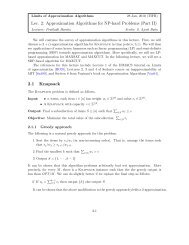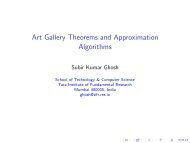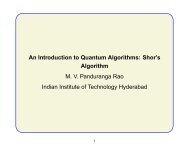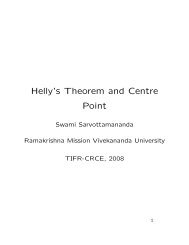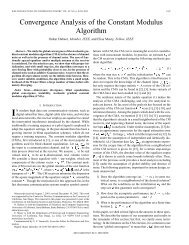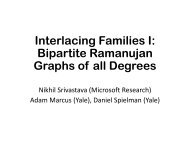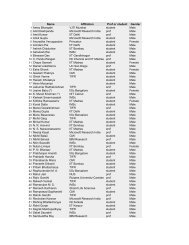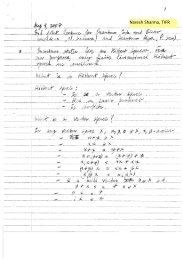Lecture 6 1 Exponential of a linear operator
Lecture 6 1 Exponential of a linear operator
Lecture 6 1 Exponential of a linear operator
You also want an ePaper? Increase the reach of your titles
YUMPU automatically turns print PDFs into web optimized ePapers that Google loves.
Quantum algorithms Monsoon 2007<br />
<strong>Lecture</strong> 6<br />
<strong>Lecture</strong>r: Pranab Sen Date: August 16<br />
In this and the next lecture, we shall learn how to approximate a unitary operation on n qubits by a circuit<br />
composed <strong>of</strong> CNOT and single qubit gates. Moreover, we shall show that only a finite set <strong>of</strong> single qubit<br />
gates are required, thus proving the existence <strong>of</strong> a finite universal set <strong>of</strong> basic gates for quantum computation.<br />
Our approach will be different from the approach detailed in Nielsen and Chuang’s textbook; in fact, our<br />
approach is the solution to a problem at the end <strong>of</strong> Chapter 4 <strong>of</strong> the textbook.<br />
The advantage <strong>of</strong> the approach in the textbook is that it shows by a direct decomposition that any unitary<br />
on n qubits can be expressed exactly by a circuit consisting <strong>of</strong> CNOTs and single qubit gates, provided<br />
arbitrary single qubit gates are allowed. The textbook then indicates how an arbitrary single qubit gate can<br />
be approximated by a circuit made up <strong>of</strong> a finite universal set <strong>of</strong> basic single qubit gates. Our approach will<br />
incur an approximation error in decomposing a unitary on n qubits into a circuit <strong>of</strong> CNOTs and single qubit<br />
gates, but it will use a restricted, though still infinite, set <strong>of</strong> single qubit gates. The attraction in our approach<br />
is that it uses some nice and important mathematics on the way, and also, it is easier to prove that the single<br />
qubit gates arising in our approach can be approximated by circuits <strong>of</strong> gates from a finite universal set <strong>of</strong><br />
basic single qubit gates. At the end <strong>of</strong> the day, the textbook approach appeals to a deep result called Solovay-<br />
Kitaev theorem in order to improve the approximation error <strong>of</strong> the circuit for a generic n-qubit unitary at the<br />
expense <strong>of</strong> a mild blowup in the circuit size; it uses the theorem for 2 × 2 unitaries. Similarly, we can use<br />
the Solovay-Kitaev theorem for 2 n × 2 n unitaries to achieve a similar approximation errors and circuit sizes<br />
for generic n-qubit unitaries, however, it will be less practical than the textbook approach.<br />
Before we can dive into our decomposition technique, we need to develop a couple <strong>of</strong> mathematical<br />
concepts, namely, exponentials <strong>of</strong> <strong>linear</strong> <strong>operator</strong>s and generalised Pauli matrices on n qubits.<br />
1 <strong>Exponential</strong> <strong>of</strong> a <strong>linear</strong> <strong>operator</strong><br />
Let A be a complex n × n matrix. The exponential <strong>of</strong> A is defined as<br />
e A := 1 + A + A2<br />
+ · · ·<br />
2!<br />
It is fairly easy to show that the series converges entry-by-entry to some n × n matrix; thus, the matrix<br />
exponential is well-defined. For an invertible n × n matrix B, it is easy to see that eBAB−1 = BeAB −1 ,<br />
which proves that the exponential is actually a map from <strong>linear</strong> <strong>operator</strong>s on Cn to <strong>linear</strong> <strong>operator</strong>s on Cn .<br />
If n × n matrices A, B commute, then it is easy to see that eA+B = eAeB . In general however,<br />
eA+B = eAeB . The Trotter formula proved below quantifies the difference between the left and right hand<br />
sides <strong>of</strong> the above expression in terms <strong>of</strong> the spectral norms <strong>of</strong> A and B. Recall that the spectral norm <strong>of</strong> an<br />
<strong>operator</strong> A on Cn , also known as the ℓ − 2-induced <strong>operator</strong> norm, is defined by A := maxv:v=1 Av,<br />
where the norm for vectors is assumed to be the usual ℓ2 (Euclidean) norm. It is easy to verify the norm<br />
properties <strong>of</strong> · and also its submultiplicativity viz. AB ≤ A · B. Also, it is easy to check that A<br />
is equal to the largest singular value <strong>of</strong> A.<br />
6-1
Quantum algorithms <strong>Lecture</strong> 6 Monsoon 2007<br />
Theorem 1.1 (Trotter formula). For complex n × n matrices A, B such that A + B ≤ 1,<br />
Pro<strong>of</strong>: It is easy to see that<br />
e A+B − e A e B =<br />
e A+B − e A e B ≤ (A + B) 2 .<br />
<br />
(A + B) 3<br />
+<br />
BA − AB<br />
2<br />
3!<br />
<br />
B2 A2 A + · · · −<br />
2! 2!<br />
<br />
A3 B3 + · · · − + · · · − + · · · −<br />
3! 3!<br />
<br />
A2 B2 + · · · B + + · · · + · · · .<br />
2! 2!<br />
Using the triangle inequality (which also holds for the infinite summation here since the exponential series<br />
converges) and submultiplicativity <strong>of</strong> the spectral norm, we get<br />
e A+B − e A e B <br />
AB − BA (A + B) 3<br />
A3 B3 ≤ +<br />
+ · · · + + · · · + + · · · +<br />
2<br />
3!<br />
3! 3!<br />
<br />
B2 A2 A2 B2 A + · · · + + · · · B + + · · · + · · · .<br />
2! 2! 2! 2!<br />
Using elementary calculus, it can be checked that x3<br />
3!<br />
e A+B − e A e B ≤<br />
AB − BA<br />
2<br />
A 2 B 2<br />
+ (A + B)3<br />
x3 x2<br />
+ · · · ≤ 3 and 2! + · · · ≤ x2 for 0 ≤ x ≤ 1. Hence,<br />
<br />
A3 B3<br />
+ +<br />
3<br />
3 3 + AB2 + A 2 <br />
B +<br />
2(A + B)3<br />
≤ A · B +<br />
3<br />
(A + B)2<br />
≤ +<br />
4<br />
2(A + B)3<br />
+<br />
3<br />
(A + B)4<br />
≤ (A + B) 2 ,<br />
+ A 2 B 2<br />
16<br />
where the last two inequalities are easy to verify. This completes the pro<strong>of</strong> <strong>of</strong> the theorem. <br />
We conclude this section with a digression about how to compute e A for an arbitrary complex n × n<br />
matrix A in time polynomial in n, assuming that e z , z ∈ C can be computed in unit time. The Jordan<br />
canonical form expresses A as A = B(D + N)B −1 , where B is invertible, D is diagonal, N is upper<br />
triangular with zeroes on the diagonal, and DN = ND. Then, e A = Be D e N B −1 . Since D is diagonal,<br />
e D is easy to compute (just take exponentials <strong>of</strong> the diagonal elements). It is easy to verify that N n = 0;<br />
thus, e N is a finite series and can be computed in time polynomial in n. Since the Jordan canonical form can<br />
be computed in time polynomial in n, we get a polynomial time algorithm for computing e A . The Jordan<br />
canonical form also enables us to prove the following interesting result:<br />
Proposition 1.1. For any complex n × n matrix A, det A = e Tr A .<br />
Pro<strong>of</strong>: Consider the Jordan canonical form A = B(D + N)B −1 described above. It is obvious that<br />
Tr A = Tr (D + N) = Tr D. Observe that for a diagonal matrix D, det e D = e Tr D . Also, e N is an<br />
upper triangular matrix with ones on the diagonal; hence det e N = 1. Thus, det e A = (det e D )(det e N ) =<br />
e Tr D = e Tr A . <br />
6-2
Quantum algorithms <strong>Lecture</strong> 6 Monsoon 2007<br />
2 Generalised Pauli matrices on n qubits<br />
The <strong>linear</strong> <strong>operator</strong>s on Cn form an inner product space over C under the Hilbert-Schmidt inner product<br />
〈A, B〉 := Tr A † B. Fix an orthonormal basis |p〉, p = 1, . . . , n for Cn . If we think <strong>of</strong> <strong>linear</strong> <strong>operator</strong>s<br />
A, B as matrices with respect to this orthonormal basis, the Hilbert-Schmidt inner product is nothing but<br />
the<br />
<br />
usual dot product applied to the vectors obtained by stretching out the matrices A, B, that is, 〈A, B〉 =<br />
p,q A∗pqBpq. The norm on <strong>operator</strong>s defined by the Hilbert-Schmidt inner product is called the Frobenius<br />
norm AF := Tr A † A =<br />
p,q |Aij| 2 . Observe that AF = UAV F for any unitary <strong>operator</strong>s<br />
U, V on Cn n . This implies that AF = p=1 s2p(A), where {sp(A)} n p=1 are the singular values <strong>of</strong> A.<br />
The n2 <strong>linear</strong> <strong>operator</strong>s |p〉〈q|, p, q = 1, . . . , n form an orthonormal basis under the Hilbert-Schmidt inner<br />
product for the space <strong>of</strong> <strong>linear</strong> <strong>operator</strong>s on Cn .<br />
Now, observe that the Hermitian <strong>linear</strong> <strong>operator</strong>s on Cn form an inner product space over R under the<br />
Hilbert-Schmidt inner product, that is, R-<strong>linear</strong> combinations <strong>of</strong> Hermitian <strong>operator</strong>s are Hermitian, and<br />
〈A, B〉 ∈ R for Hermitian A, B as can be easily checked. The dimension <strong>of</strong> this R-<strong>linear</strong> space is also n2 ;<br />
the <strong>linear</strong> <strong>operator</strong>s |p〉〈p|, |p〉〈q|+|q〉〈p|<br />
√ 2<br />
and −√−1|p〉〈q|+ √ −1|q〉〈p|<br />
√ , p, q = 1, . . . , n, p = q form an orthonormal<br />
2<br />
basis under the Hilbert-Schmidt inner product. For n = 2, the 2 × 2 Pauli matrices<br />
1 =<br />
1 0<br />
0 1<br />
<br />
, X =<br />
0 1<br />
1 0<br />
<br />
, Y =<br />
0 −i<br />
i 0<br />
<br />
, Z =<br />
1 0<br />
0 −1<br />
where i := √ −1 form an orthogonal basis for the R-<strong>linear</strong> space <strong>of</strong> 2 × 2 complex Hermitian matrices.<br />
Morevoer, P F = √ 2 for all P ∈ {1, X, Y, Z}.<br />
The n-fold tensor products <strong>of</strong> the 2 × 2 Pauli matrices are called generalised Pauli matrices on n qubits.<br />
By standard properties <strong>of</strong> tensor product, the 4 n generalised Pauli matrices on n qubits are orthogonal<br />
under Hilbert-Schmidt inner product and each <strong>of</strong> them has Frobenius norm √ 2 n . Thus, the generalised<br />
Pauli matrices on n qubits form an orthogonal basis for the R-<strong>linear</strong> space <strong>of</strong> 2 n × 2 n complex Hermitian<br />
matrices. In the rest <strong>of</strong> this lecture and the next, we use P to denote a generalised Pauli matrix on n qubits.<br />
Hence, any 2 n × 2 n Hermitian matrix H can be expressed as H = P h P P , where h P ∈ R. Moreover for<br />
any P , 〈 P , H〉 = h P 〈 P , P 〉 implying that<br />
|h P | ≤ P F · HF<br />
P 2 F<br />
≤ H√ 2 n<br />
P F<br />
= H.<br />
The two inequalities above follow from Cauchy-Schwarz inequality and the facts that the spectral and Frobenius<br />
norms <strong>of</strong> H are the ℓ∞ and ℓ2-norms <strong>of</strong> the vector <strong>of</strong> singular values <strong>of</strong> H.<br />
3 Simplifying arbitrary n-qubit unitary matrices<br />
In this section, we take the first step towards approximating an arbitrary n-qubit unitary U by a circuit<br />
composed <strong>of</strong> CNOTs and single qubit gates. We will show in this section that U can be approximated by a<br />
product <strong>of</strong> unitaries <strong>of</strong> a special kind viz. those unitaries whose Hamiltonians are scaled generalised Pauli<br />
matrices on n qubits.<br />
6-3<br />
<br />
,
Quantum algorithms <strong>Lecture</strong> 6 Monsoon 2007<br />
By working in the eigenbasis <strong>of</strong> U and using the spectral theorem, it is easy to see that U can be written<br />
as U = e −iH , where i = √ −1 and H is an n-qubit Hermitian matrix with eigenvalues in the range (−π, π],<br />
that is, H ≤ π. Thus, H can be expressed as H = P h P P , where h P ∈ R and |h P | ≤ H ≤ π.<br />
Lemma 3.1. Let H be a 2n × 2n Hermitian matrix and 0 ≤ δ ≤ (3π) −1 . Let H = P h <br />
P P , hP ∈ R.<br />
Then, <br />
<br />
e −iHδ − <br />
e −iδh <br />
<br />
<br />
P P <br />
<br />
≤ (3πδ)24 n .<br />
P<br />
Pro<strong>of</strong>: The pro<strong>of</strong> is by induction on the number <strong>of</strong> non-zero terms m in the decomposition <strong>of</strong> H into a<br />
R-<strong>linear</strong> combination <strong>of</strong> generalised Pauli matrices on n qubits. The base case m = 1 is trivial. Now<br />
suppose m > 1. Let T (m) be the left hand side <strong>of</strong> the above inequality when the decomposition <strong>of</strong> H has<br />
m non-zero terms, that is, H = m l=1 hl Pl. Then, by the triangle inequality and submultiplicativity <strong>of</strong> the<br />
spectral norm,<br />
<br />
<br />
<br />
T (m) := l=1 hl m<br />
Pl − e −iδhl <br />
<br />
Pl<br />
<br />
≤<br />
≤<br />
e−iδ P m<br />
<br />
<br />
e −iδ P m<br />
<br />
<br />
<br />
<br />
e−iδ P m−1<br />
<br />
m−1 <br />
δ<br />
l=1<br />
<br />
l=1<br />
l=1 hl Pl −iδ<br />
− e Pm−1 l=1 hl Pl −iδhm · e <br />
Pm<br />
+<br />
l=1 hl m−1 <br />
Pl − e −iδhl <br />
<br />
Pl<br />
<br />
hl Pl<br />
l=1<br />
<br />
<br />
<br />
<br />
+ δhm Pm<br />
2<br />
· e−iδhm Pm <br />
+ T (m − 1) · 1.<br />
The last inequality follows because e −iδhm Pm is a unitary matrix, and by using Trotter’s formula (Theo-<br />
rem 1.1). Note that we can indeed use Trotter’s formula because<br />
<br />
<br />
<br />
<br />
δ<br />
m−1 <br />
hl <br />
<br />
<br />
Pl<br />
+ δhm Pm = δ(H − hm Pm + hm Pm)<br />
l=1<br />
≤ δ(H + 2hm Pm)<br />
≤ δ(π + 2π · 1)<br />
= 3πδ ≤ 1.<br />
Above, we used the triangle inequality and the facts that Pm is unitary, |H| ≤ π and |hm| ≤ |H| ≤ π.<br />
We thus get a recurrence T (m) ≤ (3πδ) 2 + T (m − 1), T (1) = 0. Solving the recurrence, we get<br />
T (m) ≤ (3πδ) 2 (m − 1). Putting m ≤ 4 n gives us the right hand side <strong>of</strong> the desired inequality. <br />
Lemma 3.2. Let H be a 2n × 2n Hermitian matrix, 0 ≤ ɛ ≤ 1 and k := (3π) 24nɛ−1 . Let H = P h <br />
P P ,<br />
hP ∈ R. Then,<br />
<br />
<br />
<br />
<br />
e<br />
<br />
<br />
−iH ⎛<br />
− ⎝ <br />
e −ih ⎞k<br />
<br />
P P /k⎠<br />
<br />
<br />
≤ ɛ.<br />
P<br />
6-4
Quantum algorithms <strong>Lecture</strong> 6 Monsoon 2007<br />
Pro<strong>of</strong>: Let 1 ≤ m ≤ k. By induction on m, we shall show that<br />
<br />
<br />
<br />
T (m) := <br />
<br />
e−imH/k ⎛<br />
− ⎝ <br />
e −ih ⎞m<br />
<br />
P P /k⎠<br />
<br />
<br />
≤ mɛ2<br />
P<br />
(3π) 2 .<br />
4n The base case m = 1 holds because we can set δ := k−1 in the previous lemma (Lemma 3.1) to get<br />
<br />
<br />
<br />
<br />
<br />
e−iH/k − <br />
e −ih <br />
<br />
<br />
P P /k<br />
<br />
≤<br />
ɛ2 (3π) 2 .<br />
4n P<br />
Now suppose m > 1. We use the triangle inequality and submultiplicativity <strong>of</strong> · to prove the induction<br />
step.<br />
<br />
<br />
<br />
T (m) ≤ <br />
<br />
e−imH/k <br />
−i(m−1)H/k<br />
− e e<br />
P<br />
−ih <br />
<br />
<br />
P P /k<br />
<br />
+<br />
<br />
<br />
<br />
<br />
<br />
e−i(m−1)H/k<br />
e<br />
P<br />
−ih ⎛<br />
<br />
P P /k<br />
− ⎝ <br />
e<br />
P<br />
−ih ⎞m<br />
<br />
P P /k⎠<br />
<br />
<br />
<br />
<br />
= e −i(m−1)H/k<br />
<br />
<br />
<br />
· <br />
<br />
e−iH/k − <br />
e<br />
P<br />
−ih <br />
<br />
<br />
P P /k<br />
<br />
+<br />
<br />
<br />
<br />
<br />
<br />
e−i(m−1)H/k ⎛<br />
− ⎝ <br />
e −ih ⎞m−1<br />
<br />
P P /k⎠<br />
<br />
<br />
<br />
· <br />
e<br />
<br />
−ih <br />
<br />
<br />
P P /k<br />
<br />
<br />
≤ 1 ·<br />
≤<br />
P<br />
ɛ2 (3π) 2 + T (m − 1) · 1<br />
4n mɛ2 (3π) 2 .<br />
4n Above, we use the fact that e −i(m−1)H/k and P e −ih P P /k are unitary. Setting m = k finishes the pro<strong>of</strong> <strong>of</strong><br />
the lemma. <br />
So far we have seen how to approximate a 2 n × 2 n unitary U to within spectral distance ɛ by a product<br />
<strong>of</strong> (3π) 2 4 2n ɛ −1 unitaries <strong>of</strong> the form e −iα P , α ∈ R and P a generalised Pauli matrix on n qubits. We<br />
performed the approximation by breaking up the time evolution <strong>of</strong> the Hamiltonian <strong>of</strong> U into small intervals,<br />
and then approximating the evolution in each interval by a product <strong>of</strong> unitaries <strong>of</strong> the above special kind.<br />
The crucial reason why we could approximate U to an arbitrary accuracy was that the approximation error<br />
in a single interval was O(k −2 ), where k is the number <strong>of</strong> intervals. The overall approximation error became<br />
k · O(k −2 ) = O(k −1 ). Thus, increasing the number <strong>of</strong> intervals k increased the accuracy <strong>of</strong> approximating<br />
U. The same idea extends to discretely integrating the Schrödinger equation; increasing the number <strong>of</strong><br />
intervals increases the accuracy <strong>of</strong> the numerical solution.<br />
6-5<br />
P
Quantum algorithms <strong>Lecture</strong> 6 Monsoon 2007<br />
In the next lecture, we shall see how to implement a unitary <strong>of</strong> the form e −iα P using O(n) CNOT gates<br />
and single qubit gates <strong>of</strong> the form e −iβP , β ∈ R and P a Pauli matrix. Note that in general, e −iα P is an<br />
entangled operation over n qubits. After that, we shall indicate how we can approximate any gate <strong>of</strong> the<br />
form e −iβP by repeated applications <strong>of</strong> a basic gate e −iβ0P , where β0 is a fixed irrational multiple <strong>of</strong> π.<br />
Finally, we motivate the reason behind using the spectral distance to approximate a desired unitary U.<br />
Suppose U ′ is an approximant to U within spectral distance ɛ. Then, if the initial state <strong>of</strong> the quantum<br />
computer is |ψ0〉, the final states <strong>of</strong> the computer if the ideal unitary versus the approximating unitary were<br />
used will be |ψ〉 := U|ψ0〉 versus |ψ ′ 〉 := U ′ |ψ0〉. The difference between the two final states will be<br />
|ψ〉 − |ψ ′ 〉 = U|ψ0〉 − U ′ |ψ0〉 ≤ U − U ′ ≤ ɛ.<br />
Now let P , P ′ be the probability distributions got by performing a measurement in the computational basis<br />
on states |ψ〉, |ψ ′ 〉. It will be proved later on in the Quantum information and error correction course that<br />
P − P ′ 1 ≤ 2|ψ〉 − |ψ ′ 〉 ≤ 2ɛ, where P − P ′ 1 := <br />
m |P (m) − P ′ (m)| is the ℓ1-distance, also<br />
known as the total variation distance, between P , P ′ (here m ranges over all possible computational basis<br />
states). In fact, the above bound on the total variation distance also holds for generalised measurements. This<br />
shows that P , P ′ are nearly indistinguishable information-theoretically. In short, approximating a unitary<br />
in the spectral distance ensures that the actual output probability distribution is information-theoretically<br />
nearly indistinguishable from the ideal output probability distribution.<br />
6-6





